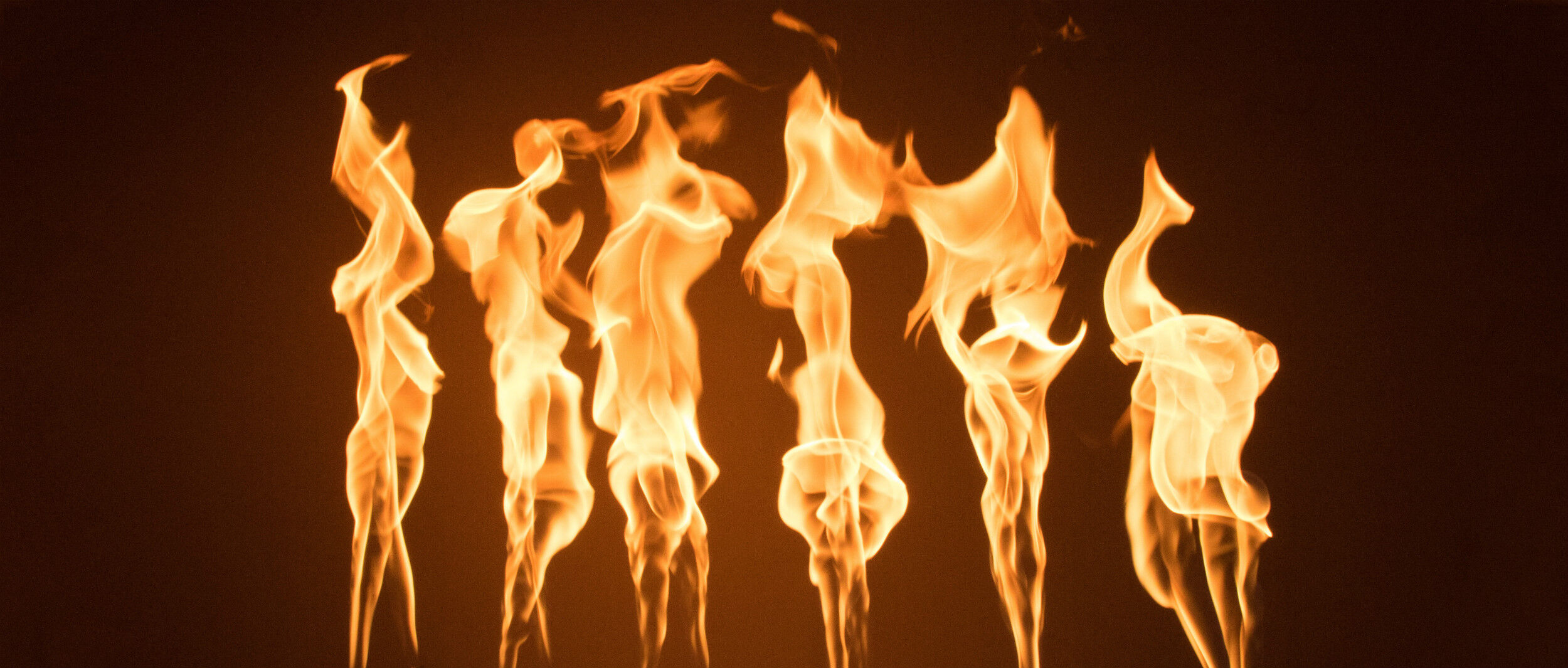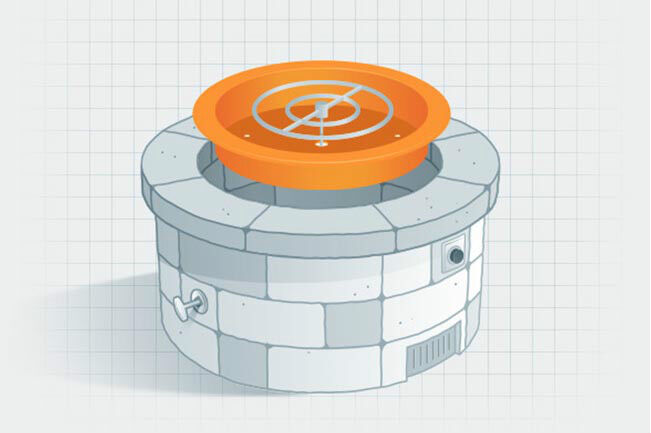By: Jeff O'Keefe, NFI Certified Master Hearth Professional
Last Updated: April 8, 2025
If you want your outdoor fire pit to have a certain flame height or pattern, an high heat output, or maximum fuel efficiency, it's important to weigh your fire pit burner options.
Some burners are designed to produce natural, campfire-like flames using minimal fuel, while others are equipped with powerful jets for bigger flames and intense heat.
The burner you should get depends on what type of fire pit you have — Natural Gas or Propane — and how you'd like to control the fire.
Below, we'll cover how burners work, installation requirements, safety tips, and how to select the best burner for your needs.
In This Article
- What is a burner?
- What fuel type should I use?
- Connecting your burner to a natural gas line
- Can I use a burner on a wood deck or under a covered patio?
- What is a burner pan, and do I need one?
- How many burner styles are there?
- How do I ignite and control my burner?
- How to choose the right burner
- Burner safety tips
- We’re here to help
- More resources
What is a Burner?
Burners are the main components used to burn the fuel in a gas-powered fire pit. They’re hollow forms with holes or ports strategically place across the surface to evenly distribute the gas, creating a natural flame pattern.
When the gas intake valve is opened, gas will flow from the source through the burner and out of the burner's holes to the surface.
We carry weather-resistant, stainless steel and brass burners from industry-leading brands, like HPC Fire, The Outdoor GreatRoom, Warming Trends, Firegear, Fire by Design, and more. Most of these high-end burners comes with a limited lifetime warranty, ensuring your investment is protected, no matter what kind of climate you live in.
Some burners use specially designed nozzles instead of punched or drilled holes to distribute the gas. This can often result in a taller, more intense flame.
The best burner shape depends on what kind of fire pit enclosure you have. For example, a fire bowl will likely need a round burner, while fire pit tables look best with square or linear burners.
What Fuel Source Can I Use with My Burner?
Most burner systems can be hooked up to a Natural Gas line or a Propane tank — either a standard, 20-lb. tank or a large, permanent tank on your property.
In most cases, if a Propane tank is used, an air mixer must be installed with your burner system to introduce more air to the fuel before combustion. Propane is such a rich gas that without the air mixer, it will generate excess soot and result in a poor flame presentation.
Can I Hook My Burner Up to a Natural Gas Line?
If you're installing a permanent gas line, it's very important that you avoid using corrugated pipe. Corrugated pipe is considered lower quality and can be easily damaged. It also causes excessive whistling, which cannot be remedied.
If considerations aren't made for the pipe size and burner capacity (BTU's) prior to purchase, you could end up with low flames and poor burner performance.
Whether you're using an existing gas line or plan on installing a new gas line, your plumber will need to know the BTU capacity of the burner to make sure the line can supply the adequate amount of gas needed for the burner to work optimally.
If the existing gas line can't, then the plumber may need to modify it in order to accommodate the new supply.
Can I Use My Burner on a Wood Deck or Under a Covered Patio?
If you plan on installing your fire pit on a combustible deck or patio, or under a gazebo, awning or covered patio, then you'll need to check the manufacturer's requirements for clearance to combustibles.
The clearance requirements will determine how close you can place your fire pit to a combustible surface or combustible materials, such as an overhang and nearby trees.
What is a Burner Pan?
Pans are solid metal pieces that sit directly underneath the burner and hold the media, like lava rock, fire glass, and gas logs. They create a separation of the burner and media from the open cavity below.
Some burners have a pan attached to them, while others require the pan to be purchased separately.
Pans come in a variety of shapes and sizes, and either sit on top of the fire pit or are recessed into it.
They are typically made out of stainless steel or aluminum since these materials can withstand constant exposure to intense heat, and resist rust and corrosion.
Do I Need a Burner Pan?
Any fire pit that uses Propane will need to have a pan under the burner. Fire pits that run on Natural Gas don't require a pan, but they are beneficial.
For installation, you'll need to ensure that there's at least 2-3 inches of clearance from the edge of the burner area to the finishing materials.
This clearance allows for the regular expansion and contraction of the pan as it heats and cools. It also prevents your finishing material from cracking due to high heat exposure.
Water can pool in the pan and flood the burner through its holes without proper drainage. To prevent this from happening, pans will typically have drainage holes. If water does get into the burner, then it can leak into the gas line.
Any water in your gas line will need to be purged by a licensed gas professional. You can save yourself both time and money by using a burner cover when the fire pit is not in use.
How Many Burner Options Are There?
Burners come in many different shapes, sizes, styles, and unique configurations. They can have a single ring or multiple rings and can be customized to fit almost any desired flame presentation.
Shapes and styles available include:
How Do I Ignite and Control My Burner?
There are a few different ignition systems for burners and ways to control the gas flow. Ignition systems include match lit (manual), automatic, and push button.
The gas flow can be controlled by a key valve, control knob, remote control, switch, or even with your smart device through modern Bluetooth controls.
If you're considering using an automatic ignition system with your gas fire pit, then you may need to have an electrical line run to the fire pit area.
Some automatic ignitions are battery operated and won't require a permanent source of electricity, but most automatic ignitions, like AWEIS (All Weather Electronic Ignition System) systems, require a permanent power source and special considerations prior to installation.
How to Pick Out a Burner
- Determine the size and shape of the fire pit that will fit in your outdoor space
- Determine the heat output, flame size, and presentation you want
- Choose your fuel type — Natural Gas or Propane
- Determine which ignition system will be the best fit for you — manual, push-button, or electronic
- Pick out your favorite media (gas logs, lava rock, fire glass, etc.)
- Select a few burners that fit the size and shape of your fire pit
- Read the manufacturer requirements and consult the owner's manual to make sure the burners are compatible with your chosen fuel type, media, heat output, and flame presentation
- Narrow down the list until you've found the best burner to suit your needs
Learn More About the Different Burner Types
Fire Pit Burner Safety Tips
- For the safest option, look for a burner that is UL approved and CSA tested. This will ensure the burner has undergone rigorous testing to verify it's a reliable and safe heating appliance
- Read the owner's manual thoroughly before installing or using the burner
- Follow the recommendations in the installation manual for the proper amount of media to use
- If there is a spark ignition in your fire pit, don't cover it with the media. Leave enough space around it so it can light properly
- Clean out the ignition and burner area regularly to prevent bugs, dirt, and debris from building up
- Have your gas line, gas connections, fittings, burner, and fire pit inspected annually by a licensed gas professional to make sure they are in good working order
We're Here to Help
Do you still have questions about what type of burner you need? Call us at (800) 919-1904 to speak with one of our NFI Certified specialists today!
More Resources
Not sure if you want a Propane or Natural Gas fire pit? Read the benefits of each here.
While the ambiance of a wood burning fire pit is charming and cozy, the convenience and cleanliness offered by gas fire pits is well worth the investment. Explore the upsides of both fire pit styles.
Dive into our comprehensive Gas Fire Pit Buying Guide to find the perfect look for your outdoor retreat.
 |
Jeff O'Keefe is a skilled Technical Sales Representative with a decade of experience at Woodland Direct. As an NFI-Certified Master Hearth Professional, Jeff has helped clients complete a variety of projects, from selecting a fire pit to customizing an indoor fireplace. When he's not working, Jeff escapes to The Great Outdoors. He enjoys exploring new hiking trails, fishing, hunting, and dirt biking. His love for adventure and the outdoors is reflected in his passion for creating warm, inviting spaces that bring people together. Call Jeff or one of our experts in fire at 800.919.1904. |



